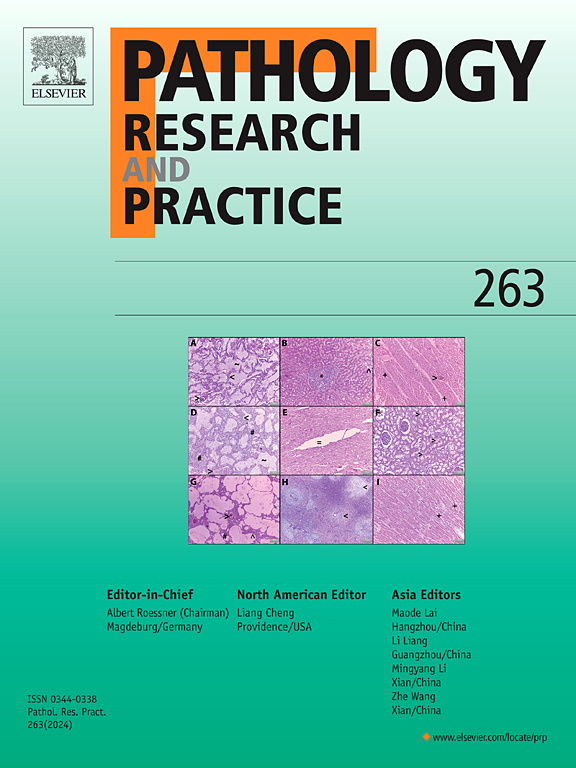胡椒明作为一种靶向结直肠癌差异表达基因治疗药物的综合计算和实验验证。
IF 3.2
4区 医学
Q2 PATHOLOGY
引用次数: 0
摘要
结直肠癌(CRC)由于其高发病率和死亡率仍然是一个主要的全球健康问题。最近的研究显示了植物化合物在结直肠癌治疗中的潜力。本研究通过生物信息学和实验相结合的方法,探讨了天然植物化合物胡椒隆明(PIP)在结直肠癌中的抗癌潜力。最初,GEO、CTD和GeneCards的综合计算数据库得出了11个常见的差异表达基因,这些基因可能是PIP在CRC中靶向的,显示参与多种信号通路和凋亡信号传导。此外,蛋白-蛋白相互作用分析发现5个枢纽基因TP53、CCND1、AKT1、CTNNB1和IL1B在结直肠癌中表达显著改变,且与预后不良和转移相关。分子对接显示PIP和hub基因之间具有很强的结合亲和力,并且具有良好的药代动力学,包括高胃肠道吸收和最小毒性。对结直肠癌细胞系- SW-480和HT-29的实验验证显示其剂量依赖性细胞毒性,IC50值分别为3 μM和4 μM。此外,体外实验证实了PIP具有细胞毒性、抗迁移、促凋亡作用,并能调节中枢基因(TP53↑、CCND1、AKT1、CTNNB1、IL1B↓),支持其在结直肠癌中的机制作用。总之,这些发现支持PIP通过调节枢纽基因发挥抗癌作用,从而使其成为一种潜在的治疗CRC的药物。这项研究是相关的,因为它将计算预测与实验验证联系起来,为CRC中的天然化合物评估提供了一个系统的框架。与之前的报道不同,本研究独特地将多数据集转录组学、中心基因优先级和ADMET分析与体外基因水平验证相结合,这在以前的CRC PIP中尚未报道。本文章由计算机程序翻译,如有差异,请以英文原文为准。
Integrative computational and experimental validation of Piperlongumine as a therapeutic agent targeting differentially expressed genes in colorectal cancer
Colorectal cancer (CRC) remains a major global health concern due to its high incidence and mortality. Recent studies have shown the potential of phytocompounds in CRC therapeutics. This study explores the anticancer potential of Piperlongumine (PIP), a natural phytocompound, in CRC through an integrative bioinformatics and experimental approach. Initially, integrative computational databases of GEO, CTD and GeneCards resulted in 11 common differentially expressed genes potentially targeted by PIP in CRC, showing involvement in multiple signaling pathways and apoptotic signaling. Further, protein-protein interaction analysis identified five hub genes- TP53, CCND1, AKT1, CTNNB1 and IL1B, showing significant expression alterations and correlations with poor prognosis and metastasis in CRC. The molecular docking demonstrated strong binding affinity between PIP and hub genes, alongside favorable pharmacokinetics including high gastro-intestinal absorption and minimal toxicity. Experimental validations on CRC cell lines- SW-480 and HT-29 revealed dose-dependent cytotoxicity with IC50 values of 3 μM and 4 μM, respectively. In addition, in vitro assays confirmed PIP’s cytotoxic, anti-migratory, pro-apoptotic effects, and modulation of hub genes (TP53↑; CCND1, AKT1, CTNNB1, IL1B↓), supporting its mechanistic role in CRC. Together, these findings support that PIP exerts anticancer effects through modulation of hub genes, thus making it a potential therapeutic agent against CRC. This study is relevant as it bridges computational predictions with experimental validation, providing a systematic framework for natural compound evaluation in CRC. Unlike previous reports, this study uniquely combines multi-dataset transcriptomics, hub-gene prioritization, and ADMET profiling with in-vitro gene-level validation, which has not been previously reported for PIP in CRC.
求助全文
通过发布文献求助,成功后即可免费获取论文全文。
去求助
来源期刊
CiteScore
5.00
自引率
3.60%
发文量
405
审稿时长
24 days
期刊介绍:
Pathology, Research and Practice provides accessible coverage of the most recent developments across the entire field of pathology: Reviews focus on recent progress in pathology, while Comments look at interesting current problems and at hypotheses for future developments in pathology. Original Papers present novel findings on all aspects of general, anatomic and molecular pathology. Rapid Communications inform readers on preliminary findings that may be relevant for further studies and need to be communicated quickly. Teaching Cases look at new aspects or special diagnostic problems of diseases and at case reports relevant for the pathologist''s practice.

 求助内容:
求助内容: 应助结果提醒方式:
应助结果提醒方式:


